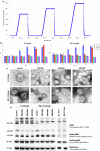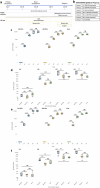Development and in vivo evaluation of a SARS-CoV-2 inactivated vaccine using high hydrostatic pressure
- PMID: 40280930
- PMCID: PMC12032236
- DOI: 10.1038/s41541-025-01136-7
Development and in vivo evaluation of a SARS-CoV-2 inactivated vaccine using high hydrostatic pressure
Abstract
Developing low-cost vaccine production strategies is crucial to achieving global health equity and mitigating the spread and impact of disease outbreaks. High hydrostatic pressure (HHP) technology is a widely used technology employed in the food industry for long-term preservation. This project aims at validating HHP as a cost-effective method for the production of highly immunogenic thermal stable whole-virus SARS-CoV-2 vaccines. Structural studies on HHP-inactivated viruses demonstrated pressure-dependent effects, with higher pressures (500-600 MPa) destabilizing viral morphology. Immunogenicity assessments, in animal models, revealed that 500 MPa treatment elicited the most robust humoral and cellular immune responses, outperforming heat inactivation. Additionally, HHP-inactivated viral preparation retained thermostability for 30 days at 4 °C, reducing cold-chain dependencies and enabling vaccine distribution also in low-resource settings. With its rapid, cost-effective, and scalable production process, HHP presents a transformative, equitable solution for global vaccine development, particularly for emerging pathogens.
© 2025. The Author(s).
Conflict of interest statement
Competing interests: There is a patent pending on the reported technology, number WO2023/248262A1. The inventors are P.R., Prof. V.S. and Dr. M.M. The remaining authors declare no competing interest.
Figures





Similar articles
-
Pressure-Inactivated Virus: A Promising Alternative for Vaccine Production.Subcell Biochem. 2015;72:301-18. doi: 10.1007/978-94-017-9918-8_15. Subcell Biochem. 2015. PMID: 26174388
-
High hydrostatic pressure inactivated human tumour cells preserve their immunogenicity.Cell Mol Biol (Noisy-le-grand). 2004 Jun;50(4):469-77. Cell Mol Biol (Noisy-le-grand). 2004. PMID: 15529756
-
Effects of pre- or post-processing storage conditions on high-hydrostatic pressure inactivation of Vibrio parahaemolyticus and V. vulnificus in oysters.Int J Food Microbiol. 2013 May 15;163(2-3):146-52. doi: 10.1016/j.ijfoodmicro.2013.02.019. Epub 2013 Mar 5. Int J Food Microbiol. 2013. PMID: 23545264
-
High hydrostatic pressure for development of vaccines.J Food Prot. 2009 Jul;72(7):1500-8. doi: 10.4315/0362-028x-72.7.1500. J Food Prot. 2009. PMID: 19681278 Review.
-
Aspects of high hydrostatic pressure food processing: Perspectives on technology and food safety.Compr Rev Food Sci Food Saf. 2021 Jul;20(4):3225-3266. doi: 10.1111/1541-4337.12763. Epub 2021 May 30. Compr Rev Food Sci Food Saf. 2021. PMID: 34056857 Review.
References
-
- Thanh Le, T. et al. The COVID-19 vaccine development landscape. Nat. Rev. Drug Discov.19, 305–306 (2020). - PubMed
Grants and funding
LinkOut - more resources
Full Text Sources
Miscellaneous

